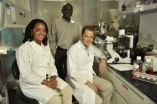(Press-News.org) VIDEO:
This visualization shows a flat map of the Earth with summertime temperature anomalies for the Northern Hemisphere. This analysis compares observed seasonal mean temperatures (June-July-August) to the seasonal mean temperatures...
Click here for more information.
A new statistical analysis by NASA scientists has found that Earth's land areas have become much more likely to experience an extreme summer heat wave than they were in the middle of the 20th century. The research was published today in the journal Proceedings of the National Academy of Sciences.
The statistics show that the recent bouts of extremely warm summers, including the intense heat wave afflicting the U.S. Midwest this year, very likely are the consequence of global warming, according to lead author James Hansen of NASA's Goddard Institute for Space Studies (GISS) in New York.
"This summer people are seeing extreme heat and agricultural impacts," Hansen says. "We're asserting that this is causally connected to global warming, and in this paper we present the scientific evidence for that."
Hansen and colleagues analyzed mean summer temperatures since 1951 and showed that the odds have increased in recent decades for what they define as "hot," "very hot" and "extremely hot" summers.
The researchers detailed how "extremely hot" summers are becoming far more routine. "Extremely hot" is defined as a mean summer temperature experienced by less than one percent of Earth's land area between 1951 and 1980, the base period for this study. But since 2006, about 10 percent of land area across the Northern Hemisphere has experienced these temperatures each summer.
In 1988, Hansen first asserted that global warming would reach a point in the coming decades when the connection to extreme events would become more apparent. While some warming should coincide with a noticeable boost in extreme events, the natural variability in climate and weather can be so large as to disguise the trend.
To distinguish the trend from natural variability, Hansen and colleagues turned to statistics. In this study, the GISS team including Makiko Sato and Reto Ruedy did not focus on the causes of temperature change. Instead the researchers analyzed surface temperature data to establish the growing frequency of extreme heat events in the past 30 years, a period in which the temperature data show an overall warming trend.
NASA climatologists have long collected data on global temperature anomalies, which describe how much warming or cooling regions of the world have experienced when compared with the 1951 to 1980 base period. In this study, the researchers employ a bell curve to illustrate how those anomalies are changing.
A bell curve is a tool frequently used by statisticians and society. School teachers who grade "on the curve" use a bell curve to designate the mean score as a C, the top of the bell. The curve falls off equally to both sides, showing that fewer students receive B and D grades and even fewer receive A and F grades.
Hansen and colleagues found that a bell curve was a good fit to summertime temperature anomalies for the base period of relatively stable climate from 1951 to 1980. Mean temperature is centered at the top of the bell curve. Decreasing in frequency to the left of center are "cold," "very cold" and "extremely cold" events. Decreasing in frequency to the right of center are "hot," "very hot" and "extremely hot" events.
Plotting bell curves for the 1980s, 1990s, and 2000s, the team noticed the entire curve shifted to the right, meaning that more hot events are the new normal. The curve also flattened and widened, indicating a wider range of variability. Specifically, an average of 75 percent of land area across Earth experienced summers in the "hot" category during the past decade, compared to only 33 percent during the 1951 to 1980 base period. Widening of the curve also led to the designation of the new category of outlier events labeled "extremely hot," which were almost nonexistent in the base period.
Hansen says this summer is shaping up to fall into the new extreme category. "Such anomalies were infrequent in the climate prior to the warming of the past 30 years, so statistics let us say with a high degree of confidence that we would not have had such an extreme anomaly this summer in the absence of global warming," he says.
Other regions around the world also have felt the heat of global warming, according to the study. Global maps of temperature anomalies show that heat waves in Texas, Oklahoma and Mexico in 2011, and in the Middle East, Western Asia and Eastern Europe in 2010 fall into the new "extremely hot" category.
### END
Research links extreme summer heat events to global warming
2012-08-06
ELSE PRESS RELEASES FROM THIS DATE:
UK riots 2011: Holding media to account after the riots
2012-08-06
News outlets need to be held to account for their coverage of the English riots, a new report has argued.
Media and the Riots: A Call for Action, published today on the first anniversary of the riots, is the first report to examine the impact of the mainstream print and broadcast media's reporting on the communities most affected.
The report, written by Dr Leah Bassel of the University of Leicester's Department of Sociology, reflects the views of those who attended the Media and the Riots conference held by the Citizen Journalism Educational Trust and citizen journalism ...
Vaginal delivery as safe as cesarean for most early preterm births
2012-08-06
Philadelphia, PA, August 6, 2012 – Vaginal delivery for early preterm fetuses presenting head first, or vertex presentation, had a high rate of success with no difference in neonatal mortality compared to cesarean delivery, a new study published in the American Journal of Obstetrics and Gynecology reports. For breech births, however, the failure rate of vaginal delivery was high and planned cesarean delivery was associated with significantly lower neonatal mortality.
"Selecting a route of delivery at less than 32 weeks' gestation is a difficult clinical decision given ...
Tale of 2 scientific fields -- ecology and phylogenetics -- offers new views of Earth's biodiversity
2012-08-06
Patterns in nature are in everything from ocean currents to a flower's petal.
Scientists are taking a new look at Earth patterns, studying the biodiversity of yard plants in the U.S. and that of desert mammals in Israel, studying where flowers and bees live on the Tibetan plateau and how willow trees in America's Midwest make use of water.
They're finding that ecology, the study of relationships between living organisms and their environment, and phylogenetics, research on evolutionary relationships among groups of organisms, are inextricably intertwined.
Results ...
Seeing through walls: Laser system reconstructs objects hidden from sight
2012-08-06
WASHINGTON, Aug. 6, 2012—Inspired by the erratic behavior of photons zooming around and bouncing off objects and walls inside a room, researchers from the Massachusetts Institute of Technology (MIT), Harvard University, the University of Wisconsin, and Rice University combined these bouncing photons with advanced optics to enable them to "see" what's hidden around the corner. This technique, described in a paper published today in the Optical Society's (OSA (http://www.osa.org)) open-access journal Optics Express (http://www.opticsinfobase.org/oe), may one day prove invaluable ...
Vanderbilt researchers find proteins may point way to new prostate cancer drug targets
2012-08-06
Two proteins that act in opposing directions – one that promotes cancer and one that suppresses cancer — regulate the same set of genes in prostate cancer, Vanderbilt-Ingram Cancer Center researchers have found.
The findings, reported recently in the Journal of Clinical Investigation, point toward potential drug targets and prognostic markers for prostate cancer.
"We are trying to understand the molecular genetics of prostate cancer: what are the genes that are altered in human prostate cancer, and very importantly, how do they lead to cancer when they are changed?" ...
New Hampshire leads nation in percent tree cover
2012-08-06
SYRACUSE. N.Y, August 6, 2012 – Tree cover in the nation's Lower 48 states covers 659 million acres, more than one-third of the nation, according to a U.S. Forest Service study of national tree cover and impervious surfaces. New Hampshire leads the nation in percent tree cover (89 percent), followed by Maine (83 percent) and Vermont (82 percent). On the other end of the spectrum, North Dakota has the lowest percent tree cover (3 percent), followed by Nebraska (4 percent) and South Dakota (6 percent).
Using aerial photograph interpretation of circa 2005 imagery, U.S. ...
A new line of defense: Researchers find cattle vaccine works to reduce E. coli O157:H7
2012-08-06
MANHATTAN, KAN. -- A commercial vaccine for cattle can effectively reduce levels of E. coli by more than 50 percent, a Kansas State University study has found. The vaccine is also effective using two doses instead of the recommended three doses, which can help cut costs for the beef industry.
David Renter, associate professor of epidemiology, is the principal investigator on a project that researched the effectiveness of products used to prevent the shedding of E. coli O157:H7 in cattle. The research appears in a recent online version of the journal Vaccine and helps ...
New approaches needed for uncovering, identifying, and treating buried chemical warfare material
2012-08-06
WASHINGTON — The current approach for identifying and destroying buried chemical munitions and related chemical warfare materials uncovered during environmental remediation projects is neither reliable enough nor has the capability to efficiently tackle large-scale projects, says a new report from the National Research Council. An alternative or modified approach is needed to remediate the Redstone Arsenal and other such projects on active and former U.S. Department of Defense sites and ranges.
Additionally, the report recommends that the Office of the Secretary of Defense ...
Off-label drug use common, but patients may not know they're taking them, Mayo finds
2012-08-06
Aug. 6, 2012
ROCHESTER, Minn. -- Many people have probably heard of off-label drug use, but they may not know when that applies to prescriptions they are taking, a Mayo Clinic analysis found. Off-label drug use occurs when a physician prescribes medication to treat a condition before that use has been approved by the Food and Drug Administration. In a newly published article in Mayo Clinic Proceedings, researchers pose and answer 10 questions about off-label drug use.
"Since the Food and Drug Administration does not regulate the practice of medicine, off-label drug ...
Airborne technology helps manage elephants
2012-08-06
Washington, D.C. – For years, scientists have debated how big a role elephants play in toppling trees in South African savannas. Tree loss is a natural process, but it is increasing in some regions, with cascading effects on the habitat for many other species. Using high resolution 3-D mapping, Carnegie scientists have for the first time quantitatively determined tree losses across savannas of Kruger National Park. They found that elephants are the primary agents—their browsing habits knock trees over at a rate averaging 6 times higher than in areas inaccessible to them. ...


